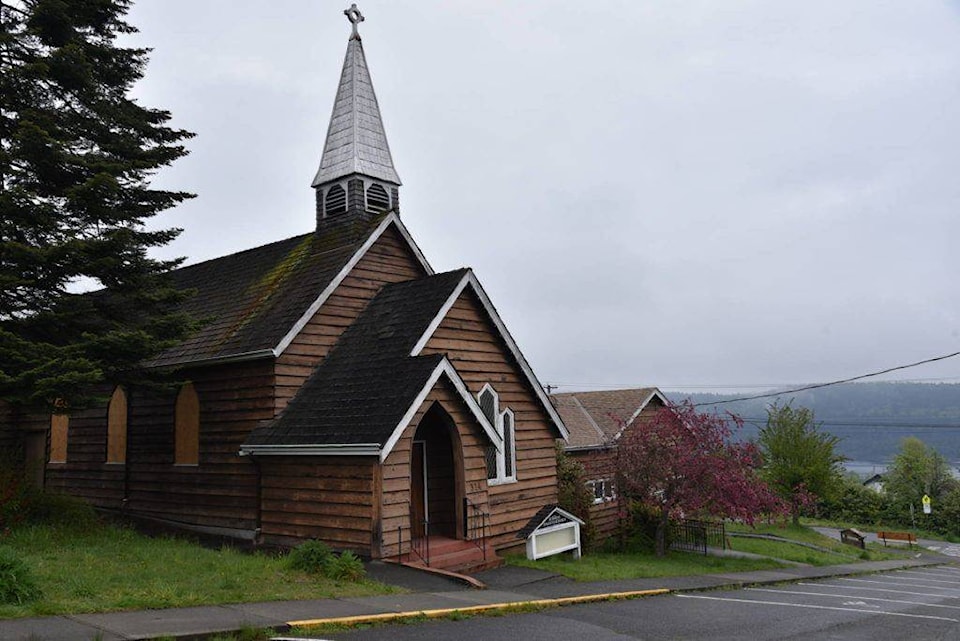The Ladysmith Resources Centre Association (LRCA) continues to advance its bold plan to be shovel ready for an integrated 36-unit affordable housing complex on the grounds presently occupied by a vacant historic church.
The LRCA purchased the St. John the Evangelist Anglican church on Buller Street from the Diocese in May 2017 with the help of a bequeathment from Pat Edge to the non-profit.
The housing project is a four-storey building that will integrate families, seniors and persons with developmental disabilities all under one roof.
Architect David Poiron has cut his teeth working with non-profits and BC Housing on various projects throughout his career, including the Nanaimo Youth Services building.
“This one was really exciting for me because it took three different groups that have needs in the community and put them together,” he said.
“You don’t see that specific mix anywhere and so Ladysmith has that ability to put these three groups together so that’s fantastic.”
The 36 apartments will be divided among 10 studio units, 23 single bedroom units and three two bedroom units. The rectangular-shaped building will stretch west along Buller with the top three levels averaging over 7,300 sq-ft.
“The majority of the suites are either fully accessible or adaptable, and adaptable basically means there’s thought that’s gone into the design of the suites that’s if someone needed to age in place or had a disability later on that certain modifications could be made to make it more accessible to them,” Poiron said.
There’s also a hall space on corner of the building that’s designed to be visible and open for use by both residents and the larger community.
LRCA board president Marsh Stevens said one of his biggest priorities with the project was creating the amenity space where possibilities are endless, including everything from LRCA programming to a resident dinner on a Friday night, or even a small weekend wedding.
“I think it will really be a bonus and I want it to be the hardest working room in the building. In some circles it might be thought of as a luxury for a building like this but it’s really not, I think it’s what makes it a home versus just housing.”
The project has two outdoor spaces, one that overlooks the harbour and a seating area along Buller Street.
LRCA board member and chair of committee spearheading the project, Guido Weisz said he’s been involved in a lot of social housing projects were the exterior is nothing but concrete.
“In this case there’s a nice courtyard created and hopefully this will get people within the community, or within the building, or both, to come together and talk and work together. Those are really important in terms of building a community.,” he said.
A neighbourhood information meeting was held at the LRCA with notice given to residents living with 60 metres of the Buller Street property.
“It’s important to get the community’s input as we move forward because we are building a community on the hill here for some very needy folks but we’re also creating an asset for the community,” added Weisz.
“Public meetings like this help us make sure that we’re understanding the concerns of the community, addressing them to the degree that we can and facilitate positive feedback about the project to the community.”
At the Aug. 20 city council meeting regarding rezoning 314 Buller Street councillors were curious if the preliminary design drawings submitted by the architect as part of the rezoning process resembled the finished project. Many of the details are still to be determined.
Mayor Aaron Stone also clarified any confusion and rumours circulating regarding potential tenants of the building.
“There’s a whole thread of information going around the community that posed this development as at-risk or comments around drug use, (or) unsavory in the neighbourhood,” he said. “This is not a halfway house, a transitional house, this is not meant to be a way to get people off the street.”
Internal momentum within the LRCA has been buzzing for months over the project. Thousands of hours have been put in by volunteers as well as staff. In addition to city council’s support, successful meetings were held with MLA Doug Routley and MP Sheila Malcolmson.
The LRCA will now be looking for support going forward from BC Housing in the coming months as well as an additional $2.5 million to complete the project.
There could be a possibility of obtaining other money from the federal government through the Canadian Mortgage and Housing Corporation and a capital fundraising campaign is also likely.
“The three things that put you in good stead are ownership of land, the ability to prove you can run the building and rezoning, or rezoning happening in a way that indicates you’re going to get it,” said Stevens. “Monday night’s (city council) meeting I think was positive, tonight we’re getting positive feedback and constructive criticism, which is great because it helps us, and from that point on we just hope that we put our best foot forward.”
editor@ladysmithchronicle.com
